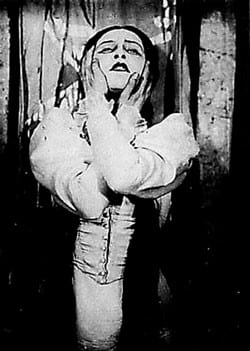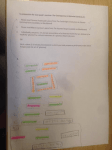In preparation to this session we had three tasks to complete: two articles to read and to prepare a presentation of a theatrical event that I believe to be explicitly ghosted by cultural memories of a previous event. (Or to pitch a performance idea which foregrounds the act of ghosting- and that’s what Mark and I are doing on our performance)
On my essay I wrote a lot about ghosting and how we use it and play it and how its affect us as artists so I hope to add something new to the discourse here. Before we had this session I perceived the term Ghosting as something that applies only for the actor. The corporal physical presence of the actor, this physical and mental encounter between the actor and the audience is forcing the audience to deal with that ghosting in order to sort or put in order what they see in front of them, coming to life. We elaborate this term to basically everything that happens in the play/film. I related to that as semiotic reading of the stage before and left the ghosting hunt the actor alone.
If we define the whole imaginary space as hunted by this ghosting, kind of like Chekhov famous quote of “If in the first act you have hung a pistol on the wall, then in the following one it should be fired. Otherwise don’t put it there.”,(From Gurlyand’s Reminiscences of A. P. Chekhov, in Teatr i iskusstvo 1904, No. 28, 11 July, p. 521.) then it would be very hard for someone like me, who is not very familiar with the British theatre tradition and came from such a different country, to read that stage correctly and layered that information in my mind at a glance, so easily and naturally.
So we can relate to the “moonlighting” episode called “atomic Shakespeare” as ghosted because it is based on the Shakespearean play “taming of the shrew”.
(Watch it hereà https://www.youtube.com/watch?v=ijUr6p8xSBM )
Another example for ghosting or a hunted stage for me is the play or the phenomena that this play has become, “The Dybbuk, or Between Two Worlds”, premieres in 1920 in Moscow, Russia. The story of bringing this play to stage is the story of how the Israeli theatre was made. Yes, the Israeli theatre started in Moscow, 28 years before the state of Israel established.
(more about thatà http://habima.millenium.org.il/vf/ib_items/1199/historyEn.pdf )
Actually the plot of play goes around the whole notion of ghosted and be hunted by them as the literal translation of the word “Dybbuk” from Hebrew is a possession or a ghost clinging on a human being. (more on the Dybbuk here à https://en.wikipedia.org/wiki/The_Dybbuk and a video of the play here à https://en.wikipedia.org/wiki/The_Dybbuk)
After staring in this iconic play as Leale, Hana Rovina, the first lady of the Israeli theatre, moving to her next role as the messiah in the play “The Golem”. The story of the golem is from the Jewish mythology about the golem from Prague, a figure made from mud that comes to life after been inserted a note with the name of god written on. So for the audience who comes to watch the play it’s already hunted by this myth fog above the play. The casting of Rovina is charging the performance with intertextuality and several levels of different meanings. Rovina is embodying the links between the messiah and the possession of Leale. For example, the possession that hunts Leale’s body is speaking in a man voice and here Rovina is talking as a man as well as the messiah is a masculine character. That is another level of awareness. The dissonance between the femininity and the masculine, the body and the soul, Rovina’s body becomes hunted by its own ghosting on and off stage.
In this picture below we see Rovina as Leale, from the production in 1920. This picture is very symbolic and for many people still represent the Israeli theatre.
If I can expand the term ghosting to another area of discourse I can say that Marina Abromivic in her work “the artist is present”.Abramovic is charging the gallery with her artistic presence and by that the art is happening. This work also was presented as part of a retroperspctiv that was recreated with art students. That’s contribute even more to the ghosting aspect of the artist on the work.
(more on that here àhttp://www.moma.org/interactives/exhibitions/2010/marinaabramovic/ )
This artistic presence can be linked to Yves Klein and other artists of the new realism or many others who used this tool of the invisible art, Klein is presenting an empty gallery, charged with the ghost of the presence of the artist. Niki de Saint Phall will shoot bags full of paint towards the canvas. The artistic product is the result of that so what we see in the gallery is the hunted product, the ghost of the artist’s actions. I already wrote about that in my essay and in the future I would like to continue and research that in the future.
The first article we had to read was explaining about what is historiography and I summed it up like this:
And the main conclusion from this was that ghosting always exist whether we like it or not and we need to take it into consideration. Because of that, every choice you, as an artist, should be full of awarenes and linked to history and heritage. Also that an historical event can be only examined in relation it had to the effect and influence on future events, That was Thomas Postelwait’s piece from the Cambridge Introduction to Theatre Historiography.
The other article we had to read was Marvin Carlson’s piece from the hunted stage[1]. Carlson define the theatre as “restored behaviour” or “twice behaved behaviour” therefore “every play is a memory play”. This is highlighting again the importance of the choses the artist id doing. The mimesis is always “something like” life, a person, an idea and so on. A good example for that is the way genres works. “ “the first function of genre is that it be recognised” and that recognition ….has been a process particularly associated with drama…”. For me it’s just like sorting my bedroom. It helps us put what we experience at the right place in our mind. Carlson continues to talk about the physical aspect. “ the recycled body of an actor, already a complex bearer of semiotics messages, will almost inevitably in a new role evoke the ghost or ghosts of previous roles if they have made any impression whatever on the audience , a phenomenon that often colours and indeed may dominate the reception process.” The collective memory of the audience and makers is hunting the performance. Therefore we can’t really do something original or new it’s all a pile of quotation. “ we love in an age of artistic recycling” therefore everything is hunted.
In class we focused mainly on the historical context and not on how to use the ghosting as a tool or explore new approaches to that. I wish we did. We understand semiotics and we understand how the historical context is important and these are not current issues. We know now that nothing is truer than another thing and that history in general depends on who wrote it, but now we need to take it to the times we live in and understand that death of the originality.
[1] Carlson, Marvin (2003) : The Hunted Stage. The Theatre as Memory Machine, Ann Arbour, university of Michigan press.

